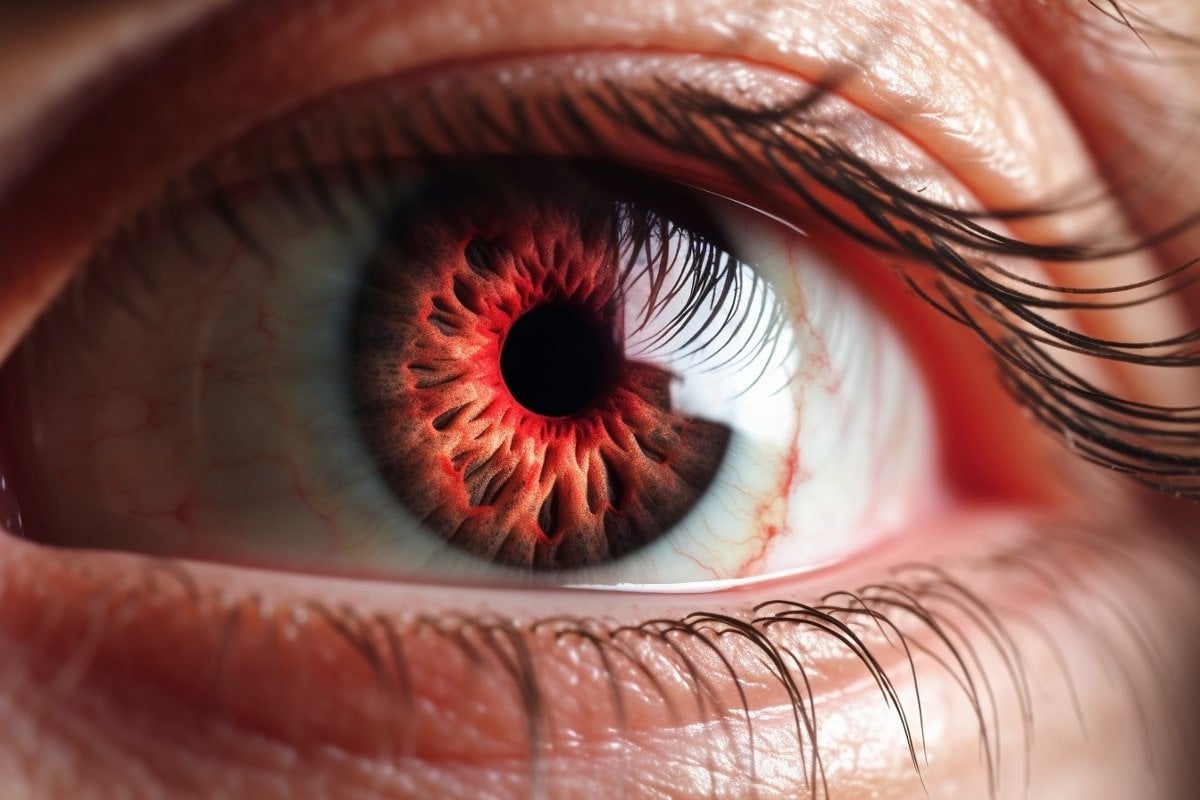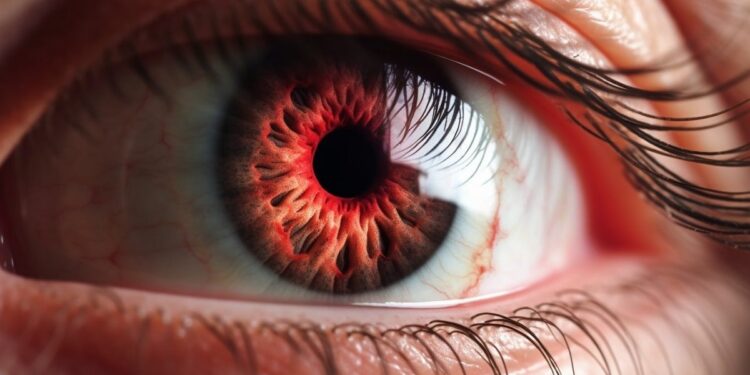Summary: Abnormalities in eye blood vessels could provide early diagnosis of Alzheimer’s disease. By comparing blood vessels in the retinas of Alzheimer’s patients, individuals with mild cognitive impairment, and healthy subjects, the team discovered a disruption in the blood-retinal barrier, which prevents harmful substances from entering the retinal tissue.
This disruption, observed even in patients with only mild functional impairment, correlated strongly with cerebral amyloid angiopathy (CAA), a condition associated with Alzheimer’s. The findings suggest that monitoring changes in eye blood vessels could offer a noninvasive route for early detection and tracking of Alzheimer’s progression.
Key Facts:
- A disruption in the blood-retinal barrier, allowing harmful substances to infiltrate retinal tissue, has been observed as an early sign of Alzheimer’s disease.
- The damage to the blood-retinal barrier was strongly linked with cerebral amyloid angiopathy (CAA) and other vascular diseases in the brain.
- Advanced retinal imaging, currently under development, could noninvasively monitor these changes in eye blood vessels to detect Alzheimer’s in living patients.
Source: Cedars-Sinai Medical Center
Blood vessel abnormalities in the eye are a major factor in the progression of Alzheimer’s disease, according to research from Cedars-Sinai investigators published in the journal Alzheimer’s & Dementia.
These changes correspond to changes in the brain, offering a new possibility for early diagnosis.
“This study provides a new understanding of the vascular changes associated with Alzheimer’s disease, especially in the retina, the layer of nerve tissue at the back of the eye,” said Maya Koronyo-Hamaoui, Ph.D., professor of Neurology, Neurosurgery and Biomedical Sciences at Cedars-Sinai and senior author of the study.
“It also points to the damage Alzheimer’s disease causes to the blood vessels in the retina, enabling a new, noninvasive pathway to early diagnosis and monitoring of disease progression.”
Investigators compared blood vessels in retinas collected from 24 human donors with Alzheimer’s disease, 10 donors with mild cognitive impairment and 27 with normal cognition.

In patients with Alzheimer’s disease and mild cognitive impairment, they found one of the earliest signs of Alzheimer’s disease to date: disruption of the blood-retinal barrier, where tightly joined cells prevent harmful substances from entering the retinal tissue.
“In patients with Alzheimer’s disease, we found that there was a deficit of as much as 70% in that barrier, meaning harmful substances can pass through and enter the retinal tissue,” said Haoshen Shi, MD, Ph.D., project scientist and first author of the study. “We see that this occurs very early on, in patients with only mild functional impairment.”
Damage to the blood-retinal barrier was strongly associated with a condition called cerebral amyloid angiopathy (CAA)—the accumulation of amyloid proteins in small blood vessels—and other vascular disease in the brain.
“Currently, the only way to detect CAA in patients is in post-mortem brain tissue samples,” said Koronyo-Hamaoui. “With additional research and the development of advanced retinal imaging, vascular and blood-retinal barrier damage could give us the first opportunity to detect CAA in living patients.”
The study also found that deposits of a protein called amyloid beta 40 accumulated in the retinal arteries of Alzheimer’s disease patients, making the arteries stiff, disrupting blood flow and preventing the arteries from clearing harmful substances from the retina.
Further studies are necessary to determine whether the deposits accumulate because of blood vessel damage, or actually cause the damage, Koronyo-Hamaoui said.
“Retinal and brain tissues are rich in blood vessels, and high blood supply is fundamental for their function,” Koronyo-Hamaoui said. “Restriction of blood supply, which may occur due to the damage we show happening here, means that these cells do not get the oxygen and the nutrients that they need.”
Advanced retinal imaging, which would look at the blood vessels and protein accumulation noninvasively in living patients, is in development but is not yet approved by the Food and Drug Administration, Koronyo-Hamaoui said.
“As an anatomical extension of the brain, the retina has been extensively examined as a window to central nervous system disorders,” said Keith L. Black, MD, chair of the Department of Neurosurgery and the Ruth and Lawrence Harvey Chair in Neuroscience at Cedars-Sinai.
“This work adds to recent progress in advanced retinal imaging and identification of other retinal biomarkers to advance the science of Alzheimer’s disease early detection.”
Meanwhile, Koronyo-Hamaoui advises people to do what they can to keep their circulatory system, including the blood vessels in the retina and the brain, healthy to help prevent CAA and dementia.
“Controlling hypertension, eating a healthy diet low in sugar, reducing alcohol consumption and avoiding smoking helps prevent chronic inflammation and damage to blood vessels,” Koronyo-Hamaoui said. “Our study shows that blood vessel damage is a major element in the progression of Alzheimer’s disease.”
About this Alzheimer’s disease research news
Author: Christina Elston
Source: Cedars-Sinai Medical Center
Contact: Christina Elston – Cedars Sinai Medical Center
Image: The image is credited to Neuroscience News
Original Research: Open access.
“Retinal arterial Aβ 40 deposition is linked with tight junction loss and cerebral amyloid angiopathy in MCI and AD patients” by Haoshen Shi et al. Alzheimer’s & Dementia
Abstract
Retinal arterial Aβ 40 deposition is linked with tight junction loss and cerebral amyloid angiopathy in MCI and AD patients
INTRODUCTION
Vascular amyloid beta (Aβ) protein deposits were detected in retinas of mild cognitively impaired (MCI) and Alzheimer’s disease (AD) patients. We tested the hypothesis that the retinal vascular tight junctions (TJs) were compromised and linked to disease status.
METHODS
TJ components and Aβ expression in capillaries and larger blood vessels were determined in post mortem retinas from 34 MCI or AD patients and 27 cognitively normal controls and correlated with neuropathology.
RESULTS
Severe decreases in retinal vascular zonula occludens-1 (ZO-1) and claudin-5 correlating with abundant arteriolar Aβ40 deposition were identified in MCI and AD patients. Retinal claudin-5 deficiency was closely associated with cerebral amyloid angiopathy, whereas ZO-1 defects correlated with cerebral pathology and cognitive deficits.
DISCUSSION
We uncovered deficiencies in blood–retinal barrier markers for potential retinal imaging targets of AD screening and monitoring. Intense retinal arteriolar Aβ40 deposition suggests a common pathogenic mechanism of failed Aβ clearance via intramural periarterial drainage.





Discussion about this post